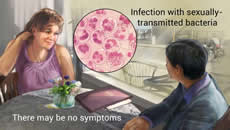Gonorrhoea
 | Gonorrhoea, also called the clap is a sexually transmitted bacterial infection that, if untreated, may cause infertility. Regular screening can help detect instances when an infection is present despite having no symptoms. |
What is it?
- It is most commonly diagnosed in men who have sex with men, among young Aboriginal and Torres Strait Islander people iving in remote and very remote areas and travellers returning from high prevalence areas overseas
- Immunity to new infection is not provided by previous infection
- It is caused by a bacteria and can affect the urethra (the tube for urine), cervix (the opening of the uterus at the top of the vagina), anus, throat and eyes
- It is spread by having unprotected vaginal, anal or oral sex with an infected person
- It can also be passed from an infected mother to her baby during birth which can cause eye infection and even blindness
Signs and Symptoms
Gonorrhoea often has no symptoms, and if left untreated can cause permanent damage and infertility in men and women.
| Male | Female |
|
Urethral discharge
|
Vaginal discharge
|
|
Dysuria
|
Dyspareunia with cervicitis
|
|
Ano-rectal symptoms: discharge, irritation, painful defecation, disturbed bowel function
|
Ano-rectal symptoms: discharge, irritation, painful defecation, disturbed bowel function
|
|
Conjunctivitis: purulent, sight threatening
|
Conjunctivitis: purulent, sign threatening
|
Diagnosis
| Male | Female |
|
First pass urine
|
Endocervical swab
|
|
Ano-rectal swab
|
Self-collected vaginal swab
|
|
Pharyngeal swab
|
First pass urine
|
|
Urethral swab
|
Ano-rectal swab
|
| |
Pharyngeal swab
|
Treatment
- Treatment with dual antibiotics
- If Gonorrhoea is not treated it can lead to serious long-term problems such as infertility and pelvic inflammatory disease
Recommended follow-up
- Advise no sexual contact for 7 days after treatment is administered
- Advise no sex with partners from the last two months until the partners have been tested and treated if necessary
- Consider testing for other STI's at three-month visit, if not undertaken at first presentation or retesting post window period
- Re-test three months after exposure
Contact tracing
- Partners should be traced back for a minimum of two months
- Contacting all sexual contacts during potential time of infection
For more information
Information about Gonorrhoea in other languages
